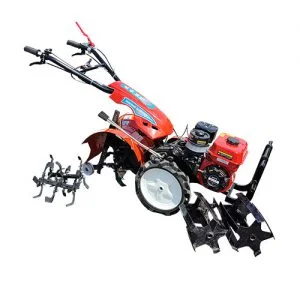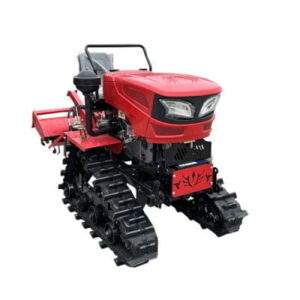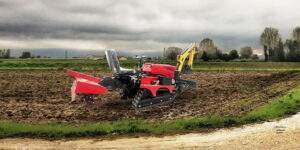How Two Wheel Walking Tractors Revolutionize Small-Scale Agriculture
Introduction

Two wheel walking tractors, also known as two wheel tractors or hand tractors, are compact and versatile agricultural machines designed for small-scale farming. These tractors have become integral to modern agriculture due to their affordability, efficiency, and adaptability to various farming tasks. Initially developed in the early 20th century, they have evolved significantly in terms of design and functionality, making them indispensable tools for small farmers around the world.
Advantages of Two Wheel Walking Tractors
Versatility: Two wheel walking tractors are incredibly versatile, capable of performing multiple agricultural tasks such as plowing, harrowing, planting, cultivating, and transporting. They can easily accommodate different attachments and implements, allowing farmers to switch between tasks efficiently without the need for multiple machines.
Cost-effectiveness: Compared to larger agricultural machinery, two wheel walking tractors are significantly more affordable both in terms of initial purchase cost and ongoing maintenance. This affordability makes them accessible to small-scale farmers who may not have the resources to invest in larger equipment.
Maneuverability: One of the key advantages of two wheel walking tractors is their ability to maneuver in small and uneven terrains where larger machines cannot operate effectively. This makes them ideal for small farms with irregularly shaped fields or areas with limited space.
Ease of Maintenance: Two wheel walking tractors are designed with simplicity in mind, featuring fewer mechanical parts and a straightforward design. This ease of maintenance reduces downtime and allows farmers to perform basic repairs and servicing themselves, minimizing dependence on external technical support.
Applications in Small-Scale Agriculture
Plowing and Tillage: Two wheel walking tractors excel in soil preparation tasks such as plowing and tillage. They can effectively break up compacted soil and prepare seedbeds, ensuring optimal conditions for planting and crop growth.
Seeding and Planting: These tractors are equipped with seeding attachments that enable precise and controlled sowing of seeds. Farmers can adjust seeding rates and depths according to crop requirements, promoting uniform germination and plant growth.
Weeding: Two wheel walking tractors support various weed control methods, including mechanical cultivation and the use of specialized implements such as weeders and cultivators. This reduces the reliance on herbicides and promotes organic farming practices.
Transportation: With the addition of trailers or carts, two wheel walking tractors can transport harvested crops, inputs like seeds and fertilizers, and other materials across the farm. This enhances logistical efficiency and reduces manual labor for farmers.
Features and Components
Engine Types and Power: Two-wheel walking tractors are typically powered by gasoline or diesel engines, with horsepower ranging from 5 to 15 HP depending on the model and manufacturer. Diesel engines are preferred for their fuel efficiency and torque, making them suitable for heavy-duty tasks.
Attachment Compatibility: Manufacturers offer a wide range of attachments and implements for two wheel walking tractors, including plows, harrows, seeders, cultivators, and trailers. These attachments are designed to be easily mounted and detached, allowing farmers to customize their tractors based on seasonal and operational needs.
Control Mechanisms: Two-wheel walking tractors are generally operated manually, with controls for throttle, clutch, and steering located conveniently for the operator. Some models may feature semi-automatic or hydraulic controls for specific tasks such as lifting and lowering implements.
Safety Features: Modern two-wheel walking tractors are equipped with safety features such as shields around moving parts, emergency stops, and ergonomic designs that prioritize operator comfort and visibility. These features mitigate risks associated with operating agricultural machinery.
Case Studies and Success Stories
Global Adoption: Two-wheel walking tractors have gained popularity in diverse agricultural regions worldwide, from Asia and Africa to Europe and the Americas. In countries like India and China, they have become essential tools for millions of small farmers, contributing significantly to food security and rural livelihoods.
Impact on Local Economies: The adoption of two wheel walking tractors has stimulated local economies by reducing labor costs, increasing agricultural productivity, and enabling farmers to diversify their crop production. This, in turn, contributes to poverty alleviation and economic growth in rural communities.
User Testimonials: Farmers who have integrated two wheel walking tractors into their operations often highlight the machines’ reliability, efficiency, and cost-effectiveness. Testimonials underscore the transformative impact of these tractors on farm productivity and overall quality of life.
Environmental Impact and Sustainability
Fuel Efficiency: Two-wheel walking tractors are known for their fuel efficiency compared to larger agricultural machinery. This reduces fuel consumption per hectare of cultivated land, lowering operating costs and environmental impact associated with greenhouse gas emissions.
Reduced Carbon Footprint: By promoting mechanical cultivation and reducing the use of chemical inputs like herbicides, two wheel walking tractors contribute to sustainable farming practices. They support soil health and biodiversity while minimizing environmental pollution.
Support for Organic Farming: Many small-scale farmers prefer using two wheel walking tractors for organic farming practices due to their ability to integrate mechanical weed control methods. This aligns with consumer demand for organic produce and enhances market opportunities for farmers.
Challenges and Limitations
Initial Investment: Despite being more affordable than larger machinery, the initial investment in a two wheel walking tractor can still be a significant barrier for small-scale farmers with limited capital. Government subsidies and financing options can help alleviate this challenge.
Training and Education: Effective operation of two wheel walking tractors requires basic technical skills and knowledge of agricultural practices. Training programs and extension services play a crucial role in educating farmers on proper use, maintenance, and safety precautions.
Adaptation to Local Conditions: Variations in soil types, topography, and cropping systems may require adjustments in tractor setup and attachment selection. Manufacturers and extension services need to provide tailored solutions that meet the specific needs of different regions.
Future Trends and Innovations

Technological Advancements: The integration of digital and smart technologies into two-wheel walking tractors is expected to enhance operational efficiency, data collection for precision farming, and remote monitoring capabilities. Innovations such as GPS guidance systems and automated controls will further optimize tractor performance.
Hybrid Models: Manufacturers are exploring hybrid models that combine traditional combustion engines with electric motors or alternative power sources. These hybrids aim to reduce fuel consumption and emissions while maintaining the power and versatility of conventional two-wheel walking tractors.
Market Expansion: As global demand for sustainable agriculture grows, there is a growing market opportunity for two-wheel walking tractors in both established and emerging economies. Manufacturers are expanding their product lines and distribution networks to reach a broader base of small-scale farmers.
Conclusion
Two-wheel walking tractors represent a fundamental innovation in small-scale agriculture, offering smallholder farmers a cost-effective, versatile, and sustainable solution for enhancing productivity and livelihoods. As technological advancements continue and market demand grows, these tractors are poised to play an increasingly crucial role in global food security and sustainable development. By addressing the unique needs of small-scale farmers and promoting environmentally friendly practices, two-wheel walking tractors contribute to a more resilient and equitable agricultural sector worldwide.
FAQ
Q:What crops can be cultivated using two wheel walking tractors?
A:Two wheel walking tractors are versatile and can be used for a wide range of crops including cereals, vegetables, fruits, and cash crops like cotton and tobacco.
Q:How durable are these tractors compared to larger models?
A:While designed for smaller operations, two-wheel walking tractors are built robustly to withstand regular use in diverse agricultural conditions. Proper maintenance ensures longevity.
Q:Can they be used on steep slopes or hilly terrains?
A:Yes, two-wheel walking tractors are suitable for navigating steep slopes and hilly terrains, providing farmers with access to otherwise challenging areas.
Q:Are spare parts readily available?
A:Most manufacturers provide a network of dealers and service centers that offer spare parts and technical support. Additionally, aftermarket suppliers often stock parts compatible with popular models.
Q:What is the average lifespan of a two wheel walking tractor?
A:With proper care and maintenance, a two wheel walking tractor can last for many years. Factors such as usage intensity and environmental conditions can influence lifespan.



